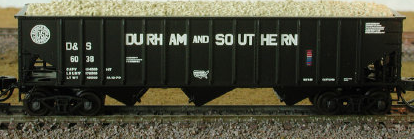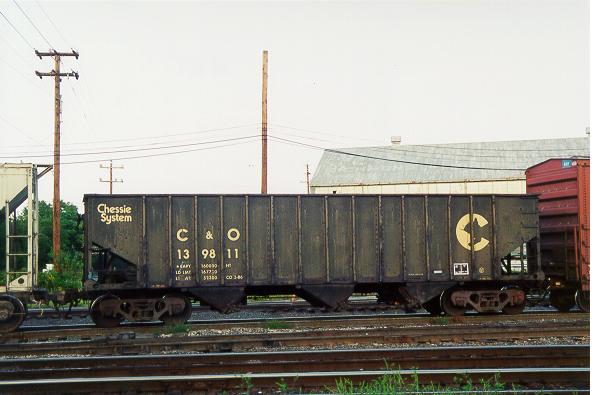Prototype History: 70 ton 3-bay rib side hoppers were a common sight on most railroads in the 20th century, These cars were built by most of the major railcar manufacturers as well as by many of the Class I railroads themselves. They were used for non weather sensitive matrial such as coal and were designed to take a beating.
Road Name History:  The Durham & Southern was incorporated in 1906 to take over a line that ran from Dunn to Apex, North Carolina and push the line onward to the city of Durham. This would provide Durham with a connection to the Seaboard Air Line and Atlantic Coast Line mainlines at Dunn. In total the D&S line was 59 miles long.
The Durham & Southern was incorporated in 1906 to take over a line that ran from Dunn to Apex, North Carolina and push the line onward to the city of Durham. This would provide Durham with a connection to the Seaboard Air Line and Atlantic Coast Line mainlines at Dunn. In total the D&S line was 59 miles long.
In the steam era, the D&S fleet of 9 engines was dominated by 2-10-0’s. One of these decapods was one of only two steam locomotives built for a common carrier in the entire country in the Depression year of 1933. Also on the roster was a former N&W 4-8-0.
For many years, the Duke family owned the D&S. They also owned Duke Power and the Piedmont & Northern Railway. For much of this period the P&N and D&S shared a management team although the two railroads did not directly connect. In the 50s, the management was split and the Dukes sold the D&S to a Durham based construction company.
The early diesel era was dominated by Baldwin road switchers (like most Baldwins, built with the long hood as the front end.) In the early 70s, a quartet of GP38-2’s was brought in to do the heavy work. In 1976, Seaboard Coast Line bought the Durham & Southern and fully merged the company in 1981.

In the steam era, the D&S fleet of 9 engines was dominated by 2-10-0’s. One of these decapods was one of only two steam locomotives built for a common carrier in the entire country in the Depression year of 1933. Also on the roster was a former N&W 4-8-0.
For many years, the Duke family owned the D&S. They also owned Duke Power and the Piedmont & Northern Railway. For much of this period the P&N and D&S shared a management team although the two railroads did not directly connect. In the 50s, the management was split and the Dukes sold the D&S to a Durham based construction company.
The early diesel era was dominated by Baldwin road switchers (like most Baldwins, built with the long hood as the front end.) In the early 70s, a quartet of GP38-2’s was brought in to do the heavy work. In 1976, Seaboard Coast Line bought the Durham & Southern and fully merged the company in 1981.
Brand/Importer Information: Bluford Shops began in 2007 as a side project of two model railroad industry veterans, Craig Ross and Steve Rodgers. They saw a gap between road names available on N scale locomotives but not available on cabooses. They commissioned special runs of Atlas cabooses in Atlantic Coast Line, Central of Georgia, Monon, Boston & Maine and Southern plus runs on Grand Trunk Western and Central Vermont on the MDC wooden cabooses. While these were in process, they began to develop their first all new tooling project, 86' Auto Parts Boxcars in double door and quad door editions in N scale. By January of 2008, Bluford Shops became a full time venture. Along with additional N scale freight cars and their own tooling for new cabooses, they have brought their own caboose line to HO scale. They also have their popular Cornfields in both HO and N. The future looks bright as they continue to develop new products for your railroad.
The town of Bluford in southern Illinois featured a small yard on Illinois Central's Edgewood Cutoff (currently part of CN.) The yard included a roundhouse, concrete coaling tower (which still stands) and large ice house. Reefer trains running between the Gulf Coast and Chicago were re-iced in Bluford. Things are more quiet now in Bluford with the remaining tracks in the yard used to stage hoppers for mines to the south and store covered hoppers. Intersecting the IC line in Bluford is Southern Railway's (currently NS) line between Louisville and St. Louis. Traffic on this single track line remains relatively heavy.
The town of Bluford in southern Illinois featured a small yard on Illinois Central's Edgewood Cutoff (currently part of CN.) The yard included a roundhouse, concrete coaling tower (which still stands) and large ice house. Reefer trains running between the Gulf Coast and Chicago were re-iced in Bluford. Things are more quiet now in Bluford with the remaining tracks in the yard used to stage hoppers for mines to the south and store covered hoppers. Intersecting the IC line in Bluford is Southern Railway's (currently NS) line between Louisville and St. Louis. Traffic on this single track line remains relatively heavy.
Item created by: CNW400 on 2020-05-21 12:24:59
If you see errors or missing data in this entry, please feel free to log in and edit it. Anyone with a Gmail account can log in instantly.
If you see errors or missing data in this entry, please feel free to log in and edit it. Anyone with a Gmail account can log in instantly.










